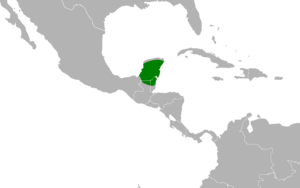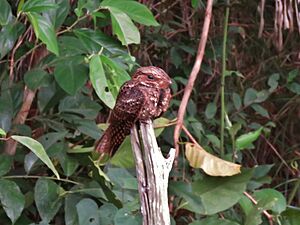Yucatan poorwill facts for kids
Quick facts for kids Yucatan poorwill |
|
|---|---|
 |
|
| Conservation status | |
| Scientific classification | |
| Genus: |
Nyctiphrynus
|
| Species: |
yucatanicus
|
 |
|
The Yucatan poorwill (Nyctiphrynus yucatanicus) is a small bird that belongs to the nightjar family. It lives in the Yucatán Peninsula, which includes parts of Belize, Guatemala, and Mexico.
Contents
What is a Yucatan Poorwill?
The Yucatan poorwill is part of a group of birds called Nyctiphrynus. It is closely related to the ocellated poorwill and the eared poorwill. Scientists believe the Yucatan poorwill and the eared poorwill are especially close relatives. This is because their songs and plumage (feathers) look and sound very similar. The Yucatan poorwill is a unique species, meaning it does not have different subspecies.
What Does a Yucatan Poorwill Look Like?
The Yucatan poorwill is a small bird, measuring about 19.5 to 22 cm (7.7 to 8.7 in) long. This makes it the smallest nightjar in the Yucatán Peninsula. A male bird might weigh around 21.3 g (0.75 oz), while a female could be about 27.7 g (0.98 oz).
These birds can have different colors. Most are dark grayish-brown with many dusky, gray, and black patterns. Their face is dark brown to brownish-black. They have a light, creamy collar on their neck and a white patch on their throat. The feathers under their body are brown and gray with black stripes. Their tail is dull black with grayish marks, and their wings are rounded. The outer four pairs of tail feathers have wide white tips.
Some Yucatan poorwills, especially females, can also be reddish-brown instead of grayish-brown. This is called a "rufous morph." The colors of these birds can vary a lot.
The eared poorwill, a similar bird, has longer wings and a clearer collar on its neck. It also has a plainer body and smaller white spots on its belly.
Where Do Yucatan Poorwills Live?
The Yucatan poorwill lives in the Yucatán Peninsula. In Mexico, you can find it in the states of Campeche, Yucatán (but not the northern coast), and Quintana Roo. Its home also stretches into northeastern Guatemala and northern Belize.
In places like the Shipstern Wildlife Reserve in Belize, these birds live there all year. They are usually seen in small groups of less than 10 birds. They live from sea level up to about 250 m (820 ft) high.
Yucatan poorwills live in many different places. These include the inside and edges of tropical forests, which can be humid or semi-humid. They also live in scrublands. They seem to be common in forests where trees lose their leaves, but they are not often found in younger, bushy forests within tropical rainforests. Scientists are still learning more about their exact habitat.
Behavior
What Do Yucatan Poorwills Eat?
The Yucatan poorwill is active during twilight (just before sunrise and after sunset) and at night. It hunts for food in open areas. It usually flies out from a tree branch to catch insects. It might also hunt from the ground. We know they eat insects, but we don't have many details about their specific prey.
Reproduction and Life Cycle
Yucatan poorwills do not build a nest. Instead, the female lays two eggs directly on the ground. Their breeding season is from April to June in Guatemala.
Even though the Yucatan poorwill and the eared poorwill look similar, their eggs are different. Yucatan poorwill eggs are described as yellowish-beige with brown spots. Eared poorwill eggs are ivory white with no spots.
When something gets too close to the nest, the adult bird sitting on the eggs might pretend to be hurt. It will land some distance away from the nest and act injured. This is a trick to make the intruder follow the adult bird instead of finding the eggs. We don't know much else about how they raise their young.
What Sounds Do Yucatan Poorwills Make?
The Yucatan poorwill's song is a loud, slightly echoing "whirr" or "whirrrr." They sing this song at night from a tree branch, mostly between February and October.
They also make other sounds. One is a slightly wet, sometimes faster "puk-puk." Another is a sharp "week week week" when they are flying. This last sound is probably an alarm call to warn others of danger. People have sometimes confused their song with the song of the Yucatan nightjar.
Their song is simple and repeats. It starts a little above 1 kHz, gets loudest at 2.2 kHz, and then drops back to 1 kHz. Each song lasts about 0.3 seconds, with a break of 1.5 to 1.8 seconds between songs.
Conservation Status
The IUCN (International Union for Conservation of Nature) first thought the Yucatan poorwill was "Near Threatened." However, since 2004, they have changed its status to "Least Concern." This means the bird is not currently at high risk of disappearing.
The Yucatan poorwill lives in a large area and is generally quite common. Even though its population is thought to be slowly decreasing, no immediate big threats have been found.



